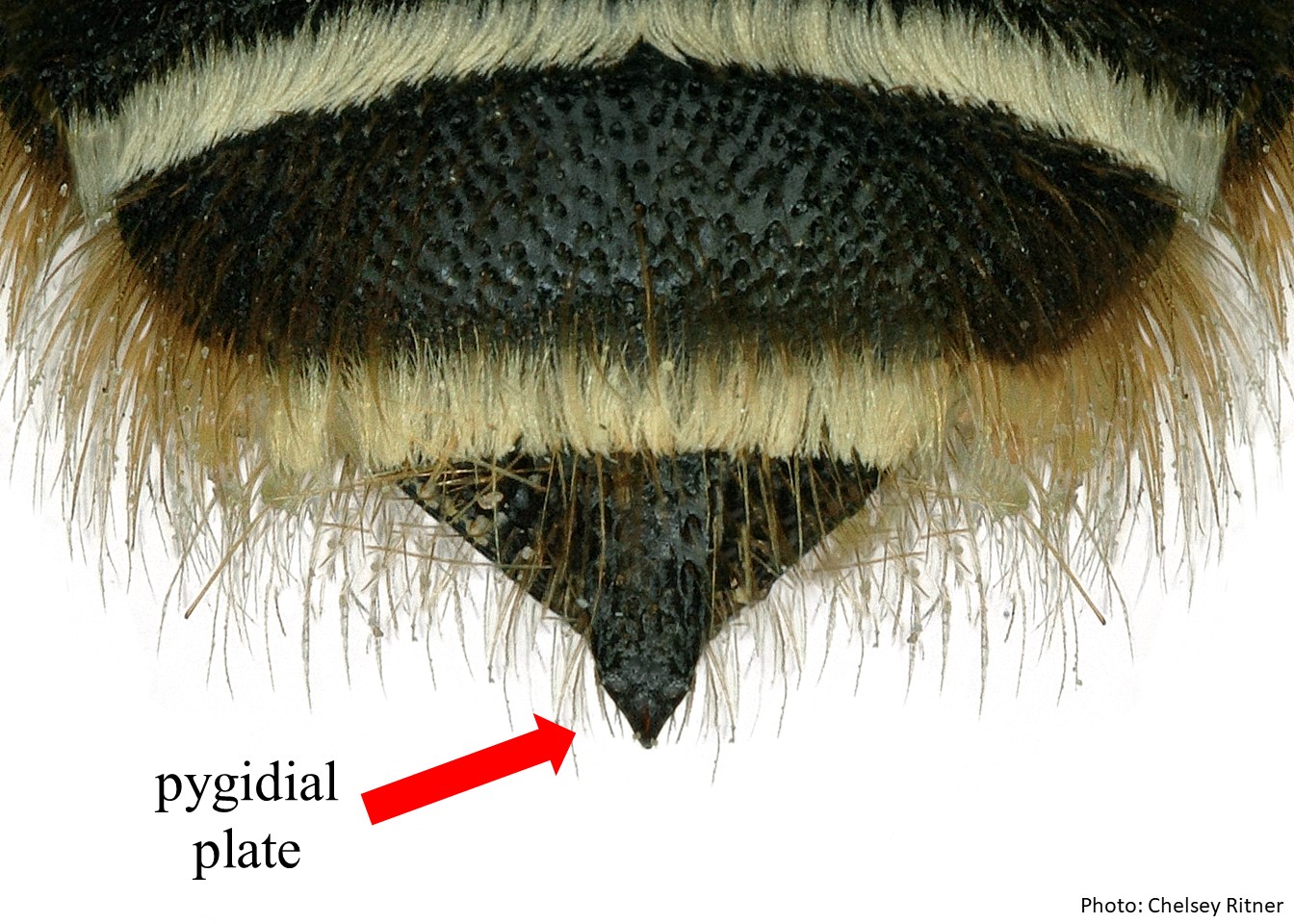Family: Apidae
Subfamily: Xylocopinae
Tribe: Xylocopini
Genus: Xylocopa
Subgenus: Copoxyla, Maa 1954
Common name: Carpenter bee
Xylocopa (Copoxyla) are smaller bees, 10 – 15 mm in length, with brilliantly metallic integumentintegument:
a tough, protective outer layer
. Males have black pubescencepubescence:
short, fine hair
on the head, legs, and on the sides and underside of the thorax and abdomen. The pubescencepubescence:
short, fine hair
is slightly lighter at the top of the thorax. Females are similar in appearance to males but may have dark brown to black pubescencepubescence:
short, fine hair
. Their wings are a transparent dark brown with a strong violet iridescent color (Hurd and Moure 1963Hurd and Moure 1963:
Hurd, P.D. and J.S. Moure. 1963. A Classification of the Large Carpenter Bees (Xylocopine) (Hymenoptera: Apoidea). University of California Publications in Entomology (Vol. 29). Berkeley and Los Angeles: University of California Press, 365 pp.).
Xylocopa (Copoxyla) includes 6 species (Hurd and Moure 1963Hurd and Moure 1963:
Hurd, P.D. and J.S. Moure. 1963. A Classification of the Large Carpenter Bees (Xylocopine) (Hymenoptera: Apoidea). University of California Publications in Entomology (Vol. 29). Berkeley and Los Angeles: University of California Press, 365 pp.; Warncke and Ruckteschellweg 1982Warncke and Ruckteschellweg 1982:
Warncke, K., Ruckteschellweg. 1982. Die Holzbienen des Vorderen Orients (Hym., Apidae). Linzer Biologische Beitraege. 14(1): 23-37.; Terzo and Rasmont 1997Terzo and Rasmont 1997:
Terzo, M., S. Iserbyt, and P. Rasmont. 2007. Reacute;vision des Xylocopinae (Hymenoptera: Apidae) de France et de Belgique. Ann. Soc. Entomol. Fr. 43(4): 445-491.).
Xylocopa (Copoxyla) can be found around the Mediterranean, up to Slovakia and southwest Russia, and into the northern Middle East (Hurd and Moure 1963Hurd and Moure 1963:
Hurd, P.D. and J.S. Moure. 1963. A Classification of the Large Carpenter Bees (Xylocopine) (Hymenoptera: Apoidea). University of California Publications in Entomology (Vol. 29). Berkeley and Los Angeles: University of California Press, 365 pp.).

Distribution map generated by Discover Life -- click on map for details, credits, and terms of use.
Members of Xylocopa (Copoxyla) are known to visit a wide variety of flowers but show a preference for the families Asteraceae, Fabaceae, and Lamiaceae (Terzo et al. 2007Terzo et al. 2007:
Terzo M., S. Iserbyt, and P. Rasmont. 2007. Reacute;vision des Xylocopinae (Hymenoptera: Apidae) de France et de Belgique. Annales de la Socieacute;teacute; Entomologique de France 43 (4): 445‒491.; Özbek 2013Ouml;zbek 2013:
Ouml;zbek, H. 2013. New Data on Large Carpenter-bees of Turkey with Considerations About Their Importance as Pollinators. Journal of Entomological Research Society 15(1): 79-89.).
(modified from Hurd and Moure 1963Hurd and Moure 1963:
Hurd, P.D. and J.S. Moure. 1963. A Classification of the Large Carpenter Bees (Xylocopine) (Hymenoptera: Apoidea). University of California Publications in Entomology (Vol. 29). Berkeley and Los Angeles: University of California Press, 365 pp.).
 short, with minimum length considerably less than half length of first flagellar segment.
short, with minimum length considerably less than half length of first flagellar segment. narrow, parallel sided, and without subapicalsubapical:
narrow, parallel sided, and without subapicalsubapical:Xylocopa (Copoxyla) may be confused with the females of X. (Ctenoxylocopa) and X. (Rhysoxylocopa). Males can be distinguished by their simple basitibial platebasitibial plate:
a small plate at the base of the hind tibia, like a kneecap and hind tibial with a single apicalapical:
near or at the apex or end of any structure
spine. Females can be distinguished by the absence of subapicalsubapical:
located just behind the apex of the segment or body part
laterallateral:
relating, pertaining, or attached to the side
spines on their pygidial platepygidial plate:
unusually flat area (a plate) surrounded by a ridge or line and sometimes sticking well off of the end of the bee; if present, found on the sixth upper abdominal segment in females, seventh in males .
.
Xylocopa (Copoxyla) constructs its nests in dead and sometimes hollow stems. Some plant species they nest in include Artemisia arborescens, Asphodelus sp., Carduus sp., Helianthus annuus, Heracleum sphondylium, Peucedanum alsaticum, and Zea sp. (Hurd and Moure 1963Hurd and Moure 1963:
Hurd, P.D. and J.S. Moure. 1963. A Classification of the Large Carpenter Bees (Xylocopine) (Hymenoptera: Apoidea). University of California Publications in Entomology (Vol. 29). Berkeley and Los Angeles: University of California Press, 365 pp.; Gerling et al. 1989Gerling et al. 1989:
Gerling, D., H. H. W. Velthuis, A. Hefetz. 1989. Binomics of the Large Carpenter Bees of the genus Xylocopa . Ann. Rev. Entomol. 34: 163-190.).
In the early 1900s, a female specimen of Xylocopa (Copoxyla) iris was collected in Brazil. This specimen could represent an unsuccessful introduction of the species to South America (Lucia et al. 2015Lucia et al. 2015:
Lucia, M., L.C. Villamil, and V.H. Gonzalez. 2015. A gynandromorph of Xylocopa augusti and an unusual record of X. iris from Brazil (Hymenoptera: Apidae: Xylocopini). Journal of Melittology 53: 1-7.). Currently, there are no known established invasives populations.
Gerling, D., H. H. W. Velthuis, A. Hefetz. 1989. Binomics of the Large Carpenter Bees of the genus Xylocopa. Ann. Rev. Entomol. 34: 163-190.
Hurd, P.D. and J.S. Moure. 1963. A Classification of the Large Carpenter Bees (Xylocopine) (Hymenoptera: Apoidea). University of California Publications in Entomology (Vol. 29). Berkeley and Los Angeles: University of California Press, 365 pp.
Lucia, M., L.C. Villamil, and V.H. Gonzalez. 2015. A gynandromorph of Xylocopa augusti and an unusual record of X. iris from Brazil (Hymenoptera: Apidae: Xylocopini). Journal of Melittology 53: 1-7.
Michener, C.D. 2007. The Bees of the World (2nd ed.). Johns Hopkins University Press, Baltimore and London, 953 pp.
Özbek, H. 2013. New Data on Large Carpenter-bees of Turkey with Considerations About Their Importance as Pollinators. Journal of Entomological Research Society 15(1): 79-89.
Terzo, M. and P. Rasmont. 1997. Révision des Xylocopa Latreille du sous-genre Copoxyla Maa des pays circum-méditerranéens (Hymenoptera, Apoidea). Bulletin de la Société Entomologique de France 102(4): 367-377.
Terzo, M., S. Iserbyt, and P. Rasmont. 2007. Révision des Xylocopinae (Hymenoptera: Apidae) de France et de Belgique. Ann. Soc. Entomol. Fr. 43(4): 445-491.
Warncke, K., Ruckteschellweg. 1982. Die Holzbienen des Vorderen Orients (Hym., Apidae). Linzer Biologische Beitraege. 14(1): 23-37.